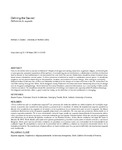Defining the Sacred

Ver/
Use este enlace para citar
http://hdl.handle.net/2183/23175
A non ser que se indique outra cousa, a licenza do ítem descríbese como Atribución-NoComercial 4.0 España
Coleccións
Metadatos
Mostrar o rexistro completo do ítemTítulo
Defining the SacredTítulo(s) alternativo(s)
Definiendo lo sagradoAutor(es)
Data
2017Cita bibliográfica
Crosbie, M. (2017). Definiendo lo sagrado. Actas De Arquitectura Religiosa Contemporánea, 5, 352-367. https://doi.org/10.17979/aarc.2017.5.0.5163
Resumo
[Resumen] ¿Cómo definimos qué es arquitectura sagrada? Las personas de todas las edades se están alejando de la religión organizada, buscando una experiencia más genuina y personal de lo espiritual. Al hablar de arquitectura sagrada, podríamos discutir si la arquitectura es sagrada en sí misma o si la arquitectura es un instrumento para evocar lo sagrado. Se deben establecer distinciones entre el espacio sagrado situacional y el sustantivo. Se cree que una presencia divina reside en el espacio sagrado sustantivo. En el caso situacional, cualquier lugar puede ser sagrado dependiendo de la presencia, ubicación y acciones de los seres humanos, a menudo actuando en comunidad. Edward Anders Sövik fue uno de los arquitectos más influyentes en el diseño de iglesias modernas en los Estados Unidos. Activo desde mediados del siglo XX hasta la década de 1970, Sövik diseñó principalmente iglesias protestantes y escribió mucho sobre el diseño eclesial y sus bases litúrgicas. Sövik creía que los primeros cristianos se percibían a sí mismos como una comunidad de fe independiente de cualquier lugar. Su escepticismo acerca de la sacralidad de los edificios y objetos se encuentra claramente dentro de la teología protestante. Su arquitectura religiosa ofrece un buen modelo para hoy, ya que la definición de arquitectura sagrada está cambiando. [Abstract] How do we define what is sacred architecture? People of all ages are turning away from organized religion, and looking for a more genuine, personal experience of the spiritual. In considering sacred architecture, a distinction is whether architecture itself is sacred or that architecture is an instrument that calls forth the sacred. Distinctions should be drawn between situational versus substantive sacred space. A divine presence is believed to reside in substantive sacred space. In situational, anyplace can be sacred depending on the presence, location, and actions of human beings, often acting in community. Edward Anders Sövik was one of the most influential architects in the design of modern churches in the US. Active from the mid-20th-century through the 1970s, Sövik designed mostly Protestant churches and wrote extensively about church design and its liturgical underpinnings. Sövik believed that early Christians perceived themselves as a community of faith unattached to any place. His skepticism about the sacredness of buildings and objects sits squarely within Protestant theology. His religious architecture offers a good model for today, as the definition of sacred architecture is changing.
Palabras chave
Espacio sagrado
Arquitectura religiosa protestante
Tendencias emergentes
Edward Anders Sovik
Universidad Católica de América
Sacred space
Protestant church architecture
Emerging trends
Catholic University of America
Arquitectura religiosa protestante
Tendencias emergentes
Edward Anders Sovik
Universidad Católica de América
Sacred space
Protestant church architecture
Emerging trends
Catholic University of America
Versión do editor
Dereitos
Atribución-NoComercial 4.0 España
ISSN
2340-5503






